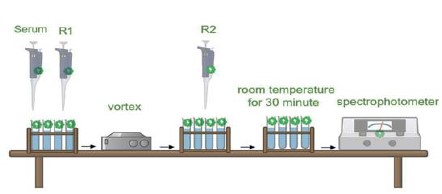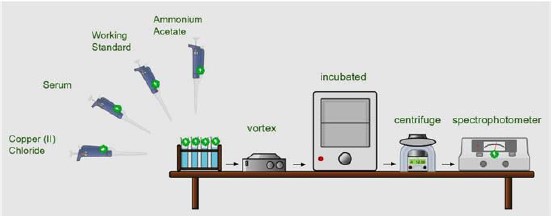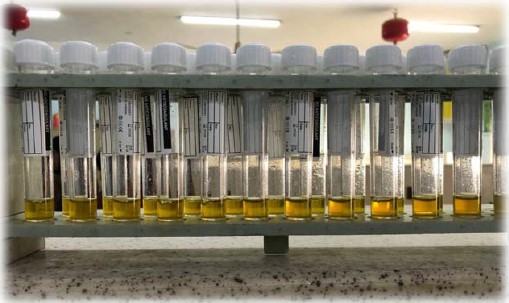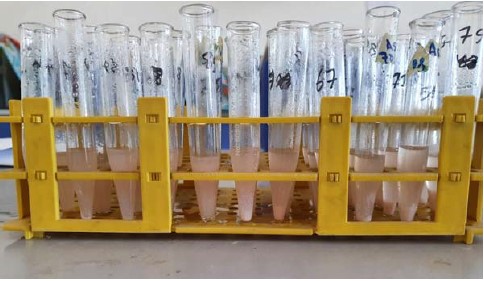Assessing the Impact of Hookah Smoking on Oxidative Stress Markers in Young Adults: A Cross-Sectional Study
| Received 21 Oct, 2023 |
Accepted 28 Feb, 2024 |
Published 30 Jun, 2024 |
Background and Objective: Hookah smoking is the most prevalent habit and the greatest health risk among those who affect the human body. The purpose of the present study was to compare the effects of hookah (Shisha) on oxidative stress in adult smokers and adult nonsmokers. Materials and Methods: The research involved 40 men aged 18 to 22. These samples were separated into two groups: 30 hookah smokers and 10 nonsmokers. Every guy is exposed to a thorough medical history questionnaire as well as regular testing to rule out any underlying illnesses or disorders. To test the blood, 5 mL samples were collected. Colorimetric approaches were used to identify biological factors. Results: Hookah had significantly higher serum concentrations of total oxidant species than non-smokers. While hookah smokers' serum total antioxidant capacity was considerably lower than that of non-smokers. The concentration of lipid peroxidation in the sera of nonsmokers and hookah smokers was investigated. The current study's findings show a substantial rise (p>0.05) in malondialdehyde concentration in all study hookah smokers, as compared to the nonsmokers control group. Conclusion: Oxidative stress, a significant health concern, is linked to chronic diseases and hookah smoking is a potential source of this stress. Therefore, it's crucial to raise awareness about the health risks and encourage quitrent or avoidance.
INTRODUCTION
Hookah smoking, also known as waterpipe smoking, is a traditional method of smoking tobacco that has gained popularity worldwide in recent years. According to the World Health Organization, approximately 100 million people worldwide are regular hookah smokers, with prevalence rates ranging from 4 to 60% in different countries1. Despite the common misconception that hookah smoking is less harmful than cigarette smoking, recent research has shown that it can be just as detrimental to health, if not more so2.
Oxidative stress is a key mechanism by which hookah smoking can damage cells and tissues in the body. It occurs when there is an imbalance between reactive oxygen species (ROS) and the body's antioxidant defence mechanisms, resulting in cellular damage and dysfunction3. Recent studies have shown that hookah smoking can increase oxidative stress in the body, leading to a range of health problems, including respiratory diseases, cardiovascular diseases and cancer4.
Several modern references have highlighted the link between hookah smoking and oxidative stress. For example, a recent study published in the Journal Inhalation Toxicology found that hookah smoke contains high levels of ROS, which can cause oxidative stress in the lungs and other organs5. Another study published in the Journal of Hazardous Materials found that hookah smoking can increase the production of free radicals in the body, leading to oxidative stress and DNA damage6. Given the growing popularity of hookah smoking worldwide and its potential health risks, it is important to understand the mechanisms by which it can cause oxidative stress and its implications for human health.
This is a general problem that many young people suffer from in Iraqi universities, especially at the University of Babylon. Therefore, a study was conducted on it to explain the causes and risks of this unhealthy phenomenon. There are many studies on the harms of smoking in the world, but present study was specific to students at the University of Babylon. In this study, a link was made between oxidative stress and smoking and what are the health effects resulting in the near future for young people and educating young people about the dangers of smoking of all kinds, especially hookah smoking and paying attention to public health and personal health. This is what that was confirmed for volunteers with samples from smokers and non-smokers. Therefore, this study aims to investigate the effects of hookah smoking on oxidative stress markers in young adults, with a view to informing public health policies and interventions to reduce the harm caused by this practice.
MATERIAL AND METHODS
Study area and duration: This study was performed on the smoker and nonsmoker students in the University of Babylon, all the blood sample were collected between from November 2022 to January 2023.
Methods
Collection of blood and sampling: The procedure involves using a vein on the elbow or forearm, tempering the arm to improve circulation. About 5 mL of blood is drawn into a needle, withdrawn and pressed onto until bleeding stops. The blood is transferred to a gel tube without anticoagulant, allowed to clot for 15 min, shrinks and serum is taken by centrifuging for 10 min at 1500 to 2000 rpm.
Subjects: A clinical study was performed in University of Babylon between from November 2022 to January 2023. Blood samples were drawn from the students of the University of Babylon.
A total of 30 male subjects ,10 subjects with non-smoking and 20 subjects with cigarette smoking.
The participants classified in to:
• |
Group 1: Nonsmokers |
|
• |
Group 2: Hookah of cigarette |
Exclusion criteria: Any chronic disease such as diabetes mellitus, thyroid diseases, malignancies, those who had been on an antioxidant therapy during the past 2 months and those with renal and liver failure were not included.
Determination of malondialdehyde (MDA) levels: Malondialdehyde (MDA) is an important oxidative product. Thiobarbituric acid (TBA) reacts with MDA, producing a color molecule that may be measured spectrophotometrically7 as shown in Fig. 1.

|

|

|
Oxidant-antioxidant system
Determination of total oxidant status (TOS): Erel developed a unique automated measuring technique that was used to measure the TOS of serum (2005) as shown in Fig. 2. The ferrous ion-o-dianisidine complex is oxidized to ferric ions by oxidants in the sample. Glycerol molecules in the reaction medium enhance oxidation. In an acidic media, the ferric ion combines with xylenol orange to form a colorful complex. Total oxidant molecules in a sample correlate with color intensity, which may be measured spectrophotometrically. The findings are given in terms of micromolar hydrogen peroxide equivalent per liter (mol Eq./L) and the test is calibrated using hydrogen peroxide8.
Total antioxidant capacity assay (TAC) (CUPRAC method): Total antioxidant capacity (TAC) is a common analyte used to determine the antioxidant status of biological samples and may measure how well the body fights off free radicals caused by a particular disease9,10 as illustrated in Fig. 3.
Statistical analysis: Data analysis was performed using SPSS 26 for Windows (SPSS Inc., Chicago, IL, USA). Data were expressed as mean, SD and were evaluated by t-test followed by LSD test. The statistical significance level was considered at p<0.05.
Ethical consideration: The ethical consideration was taken from Ethics Committee (University of Babylon/College of Science), reference number of approval: 7/19/5114 in 2/11/2023.
RESULTS AND DISCUSSION
Characteristics of the study subjects: This study was performed to the smoker and non-smoker students in the University of Babylon. Forty samples were collected from men. The samples were divided to non-smoker (NS) and hookah smoker. There were no significant differences in age between the non-smokers and smokers (Table 1).
Effect of smoking on oxidant/antioxidant status
Total oxidant status concentrations in sera of nonsmokers and hookah smokers: The results in Table 2, Fig. 4. showed the concentrations of total oxidant status (TOS) that found in sera of non-smoker (NS) was 0.54 μmol/L; while, in hookah smoker (HS) was 1.45 μmol/L. Furthermore, the standard deviation in non-smoker, hookah smoker (0.12, 0.67 μmol/L) respectively.
Free radicals are extremely reactive and unstable chemicals. Their electrons interact with other molecules within cells, causing damage to proteins, lipids, DNA and nucleotide coenzymes, among other biological materials11. Antioxidants are substances that inhibit or postpone the oxidation of biological elements found in living cells and this process is known as antioxidant defense12.
| Table 1: | Participants' characteristics included nonsmokers and hookah smokers | |||
| Group/parameter | Non-smokers (NS) |
Hookah smokers (HS) |
| Number | 10 |
30 |
| Age (Years) | 20±2 |
20±2 |
| Table 2: | Total oxidants status concentration in sera (μmol/L) of non-smokers and hookah smokers groups | |||
95% Confidence interval for mean |
||||||
| Group | N |
Mean |
Standard Deviation (SD) |
Lower bound |
Upper bound |
Significance |
| NS | 10 |
0.54 |
0.12 |
0.28 |
0.65 |
0.0001* |
| Hookah-S | 30 |
1.45 |
0.67 |
0.45 |
2.8 |
|
| *Mean difference is significant at the 0.05 level | ||||||

|
In an organism, there is a balance between the rate at which free radicals are produced and the rate at which they are destroyed. This state, known as "oxidative equilibrium," protects the organism by counteracting the harmful effects of free radicals. “Oxidative stress” is defined as an imbalance between free radical generation and antioxidant defense system that favors free radicals13. Hookah contain a high number of free radicals, which contribute to the disruption of oxidative balance and cell damage. This is the foundation of many smoking-related health issues, such as cancer, cardiovascular disease and pulmonary disease14.
Total antioxidant status (TAS) indicates the total effect of all antioxidants in plasma and body fluids, whereas entire oxidant status (TOS) reflects the total effect of all oxidants in plasma and body fluids15.
Free radicals and reactive oxygen species (ROS) found in tissues can harm biologically vital components like DNA, proteins, carbohydrates and lipids. The ROS are created during metabolic and physiological activities and in organisms that remove them by enzymatic and nonenzymatic antoxidative mechanisms, damaging oxidative reactions might occur. Under certain circumstances, a rise in oxidants and a decrease in antioxidants is unavoidable and the oxidative/antioxidative balance switches to the oxidative position. As a result, oxidative stress develops, which has been linked to over 100 illnesses.
Hookah smoking has been shown to increase oxidative stress in the body. In a study published in the Journal of Hazardous Materials, researchers measured TOS levels in hookah smokers and non-smokers. They found that hookah smokers had significantly higher TOS levels compared to non-smokers, indicating increased oxidative stress. Another study published in the Journal of Toxicology and Environmental Health found that hookah smoking increased the production of ROS in the body, leading to oxidative stress and potential cellular damage16.
Furthermore, a study published in the Journal of Clinical and Diagnostic Research found that the level of TOS increased significantly in hookah smokers after a single session of smoking17. This suggests that even occasional hookah smoking can increase oxidative stress in the body.
Total antioxidant status (μmol/L) in sera of nonsmokers, hookah smokers: The result in Table 3 and Fig. 5 shown the measuring of total antioxidant status (TAC) in smokers and non-smokers. The present study found the mean of antioxidant levels in non-smoker was 8.86 μmol/L, in hookah smoker was 7.59 μmol/L. Furthermore, the standard deviation in non-smoker, hookah smokers were (4.31, 3.34 μmol/L) respectively.

|

|
| Table 3: | Total antioxidant status in sera (μmol/L) of hookah smokers and non-smokers groups | |||
95% Confidence interval for mean |
||||||
| Group | N |
Mean |
Standard Deviation (SD) |
Lower bound |
Upper bound |
Significance |
| NS | 10 |
8.86 |
4.31 |
4.53 |
19.23 |
0.44* |
| Hookah-S | 30 |
7.59 |
3.34 |
3.69 |
19.53 |
|
| *Mean difference is significant at the 0.05 level | ||||||
| Table 4: | Lipid peroxidation (MDA concentration (μmol/L)) in sera of hookah smokers and nonsmokers groups | |||
95% Confidence interval for mean |
||||||
| Group | N |
Mean |
Standard Deviation (SD) |
Lower bound |
Upper bound |
Significance |
| NS | 10 |
1.6 |
0.72 |
0.67 |
3.15 |
0.004* |
| Hookah- S | 30 |
2.84 |
1.43 |
0.98 |
5.85 |
|
| *Mean difference is significant at the 0.05 level | ||||||
Free radicals are reactive molecules that develop in the environment when nutrients are burnt in the presence of oxygen. These compounds, known as reactive oxygen metabolites, damage cell components, resulting in oxidative stress18.
The formation and removal of free radicals from the organism are in perfect balance and free radicals have no effect on this delicate environment as long as the oxidative balance is maintained. When one of the steps working to maintain this equilibrium fails, oxidative stress occurs, which can result in cell harm in the organism. Many diseases, such as atherosclerosis, diabetes and cancer, are etiopathogenesis of oxidative stress19.
Lipid peroxidation in sera of nonsmokers and hookah smokers: The results in found that the level of MDA in sera of non-smoker (Fig. 6) was 1.60 μmol/L and in hookah smoker was 2.84 μmol/L. Furthermore, the standard deviation in non-smoker and hookah smoker were (0.72, 1.43 μmol/L) respectively as shown in Table 4.
Malondialdehyde (MDA), one of the indicators that used to assess oxidative stress, was shown to be higher in smokers. The study highlights the significant role of free radicals in human disease, highlighting the potential for increased oxidative damage in most disorders, with some playing significant pathogenic roles20.
Oxidative stress refers to an imbalance between the production of reactive oxygen species (ROS) and the body's ability to detoxify them or repair the resulting damage. Hookah smoking has been linked to increased oxidative stress in several studies. One study published in 2020 found that hookah smoking led to increased levels of oxidative stress markers in the blood, including malondialdehyde (MDA) and superoxide dismutase (SOD). The study also found that hookah smokers had lower levels of antioxidants, such as glutathione, which can help protect against oxidative damage21.
Another study published in 2021 found that hookah smoke exposure led to increased oxidative stress in the lungs of mice. The researchers found that the smoke caused oxidative damage to proteins and lipids in the lung tissue and led to increased inflammation22.
These findings suggest that hookah smoking can have harmful effects on the body's antioxidant defense mechanisms and can lead to oxidative damage and inflammation. This can contribute to the development of various diseases, including lung cancer, cardiovascular disease and chronic obstructive pulmonary disease (COPD).
Hookah smoking involves burning charcoal to heat tobacco, which is then passed through water before being inhaled through a hose or pipe. While hookah smoking has been traditionally considered less harmful than cigarette smoking, recent research suggests that it can have serious health consequences, including oxidative stress.
Several studies have shown that hookah smoking increases oxidative stress markers in the body. For example, a study published in the Journal Toxicology Mechanisms and Methods found that hookah smokers had higher levels of ROS and lower levels of antioxidant enzymes compared to non-smokers. Another study published in the Journal Inhalation Toxicology found that hookah smoking increased oxidative stress in the lungs, leading to inflammation and damage to lung tissue22.
In addition to increasing oxidative stress, hookah smoking has also been linked to a number of other health problems, including respiratory disease, heart disease and cancer. A review published in the Journal of Hazardous Materials found that hookah smoke contains a variety of toxic substances, including heavy metals, polycyclic aromatic hydrocarbons and volatile organic compounds, all of which can contribute to oxidative stress and cellular damage23.
Smoking complications are associated with increment reactive oxygen species concentration and decrement total antioxidant levels. The individuals' TOS and TAC levels were assessed. While hookah smokers' serum total antioxidant capacity was considerably lower than that of non-smokers. These findings point to oxidative stress and a smoker's oxidant defense mechanism being compromised.
The complications of hookah smoking are associated with an increase in lipid peroxide concentration in hookah smokers compared to non-smokers and consequently an increase in lipid peroxide concentration, which leads to high oxidative stress due to the formation of free radicals and the emergence of more pathological conditions in smoke.
CONCLUSION
The oxidative stress is a serious health concern that can lead to a wide range of chronic diseases. Hookah smoking is a potential source of oxidative stress and has been linked to a number of health problems. Therefore, it is important to raise awareness about the health risks of hookah smoking and to encourage individuals to quit or avoid the practice altogether.
SIGNIFICANCE STATEMENT
Hookah smoking is the most prevalent habit and the greatest health risk among those who affect the human body. The purpose is to know the effect of smoking a hookah on oxidative stress and raise awareness among young people in Iraqi universities about the impact of hookah smoking, the extent of its danger and its effect on oxidative stress, because it has increased recently. Oxidative stress is linked to chronic diseases and hookah smoking is a potential source of this stress. Hookah had significantly higher serum concentrations of total oxidant species than non-smokers. Therefore, it is recommended to conduct broader studies by identifying more common biochemical parameters linking them with the rest of the immune cytokines and explaining their importance of.
REFERENCES
- Al Lawati, J.A. and J. Mackay, 2020. Tobacco control in the Eastern Mediterranean Region: The urgent requirement for action. East. Mediterr. Health J., 26: 6-8.
- Akl, E.A., S.K. Gunukula, S. Aleem, R. Obeid, P.A. Jaoude, R. Honeine and J. Irani, 2011. The prevalence of waterpipe tobacco smoking among the general and specific populations: A systematic review. BMC Public Health, 11.
- Sies, H., 2015. Oxidative stress: A concept in redox biology and medicine. Redox Biol., 4: 180-183.
- Taati, B., H. Arazi and K. Suzuki, 2020. Oxidative stress and inflammation induced by waterpipe tobacco smoking despite possible protective effects of exercise training: A review of the literature. Antioxidants, 9.
- Badran, M. and I. Laher, 2020. Waterpipe (shisha, hookah) smoking, oxidative stress and hidden disease potential. Redox Biol., 34.
- Najeeb, H.A., K.K. Karim, G.O. Othman, A.A. Mohammed, A.M. Salih, S.S. Zuhdi and D. Jamel, 2022. DNA damage level in lymphocytes and buccal epithelial cells in Narghile smokers and non-smokers in Duhok City-KRG-Iraq. Oral Oncol. Rep., 1-2.
- Valenzuela, A., 1991. The biological significance of malondialdehyde determination in the assessment of tissue oxidative stress. Life Sci., 48: 301-309.
- Erel, O., 2005. A new automated colorimetric method for measuring total oxidant status. Clin. Biochem., 38: 1103-1111.
- Apak, R., K. Güçlü, M. Özyürek and S.E. Karademir, 2004. Novel total antioxidant capacity index for dietary polyphenols and vitamins C and E, using their cupric ion reducing capability in the presence of neocuproine: CUPRAC method. J. Agric. Food Chem., 52: 7970-7981.
- Keramat, M., M.T. Golmakani, M. Aminlari and S.S. Shekarforoush, 2018. Improving oxidative stability of virgin olive oil: Comparison of Zataria multiflora essential oil with α-tocopherol. Nutr. Food Sci. Res., 5: 19-28.
- Meo, S.D. and P. Venditti, 2020. Evolution of the knowledge of free radicals and other oxidants. Oxid. Med. Cell. Longevity, 2020.
- Gulcin, İ., 2020. Antioxidants and antioxidant methods: An updated overview. Arch. Toxicol., 94: 651-715.
- Karacay, Ö., A. Sepici-Dincel, D. Karcaaltincaba, D. Sahin and S. Yalvac et al., 2010. A quantitative evaluation of total antioxidant status and oxidative stress markers in preeclampsia and gestational diabetic patients in 24-36 weeks of gestation. Diabetes Res. Clin. Pract., 89: 231-238.
- Niaki, M.T., M.H. Sheikhha, M.A. Khalili, F. Fesahat and A. Nabi et al., 2023. Possible harmful effects of smoking hookah on sperm DNA fragmentation index and protamine genes expression in normozoospermic men. Subst. Abuse: Res. Treat., 17.
- Macvanin, M.T., Z. Gluvic, S. Zafirovic, X. Gao, M. Essack and E.R. Isenovic, 2022. The protective role of nutritional antioxidants against oxidative stress in thyroid disorders. Front. Endocrinol., 13.
- Al-Delaimy, A.K. and W.A.T. Al-Ani, 2021. Prevalence of hookah smoking and associated factors among male high school students in Iraq. BMC Public Health, 21.
- Qasim, H., A.B. Alarabi, K.H. Alzoubi, Z.A. Karim, F.Z. Alshbool and F.T. Khasawneh, 2019. The effects of hookah/waterpipe smoking on general health and the cardiovascular system. Environ. Health Prev. Med., 24.
- Nisar, B., R. Lone, S. Khan, A.N. Kamili and I. Tahir, 2023. Interactive Role of Phenolics and PGPR in Alleviating Heavy Metal Toxicity in Maize. In: Plant Phenolics in Abiotic Stress Management, Lone, R., S. Khan and A.M. Al-Sadi (Eds.), Springer Nature, Singapore, ISBN: 978-981-19-6426-8, pp: 235-263.
- Tumane, R.G., S.K. Pingle, A.S. Gaikwad and B. Ravichandran, 2023. Impact of Occupational Stress and Its Associated Factors on Cognitive, Hormonal and Stress Responsive Protein in Mining Based Industrial Workers. In: Identifying Occupational Stress and Coping Strategies, Palaniappan, K. (Ed.), IntechOpen, London, United Kingdom, ISBN: 978-1-83768-257-7.
- Souri, F., M. Badavi, M. Dianat, S.A. Mard and A. Sarkaki, 2023. Protective effects of gallic acid and SGK1 inhibitor on oxidative stress and cardiac damage in an isolated heart model of ischemia/reperfusion injury in rats. Iran. J. Basic Med. Sci., 26: 308-315.
- Record, R.A., L.H. Greiner, H. Wipfli, J. Strickland, J. Owens, J. Pugel and G.E. Matt, 2023. Evaluation of a social media campaign designed to increase awareness of thirdhand smoke among California adults. Health Commun., 38: 437-446.
- Hikisz, P. and D. Jacenik, 2023. The tobacco smoke component, acrolein, as a major culprit in lung diseases and respiratory cancers: Molecular mechanisms of acrolein cytotoxic activity. Cells, 12.
- Dai, H.D. and A.M. Leventhal, 2023. Use of traditional smokeless, snus, and dissolvable tobacco among U.S. youth. Am. J. Preventive Med., 64: 204-212.
How to Cite this paper?
APA-7 Style
Alameri,
A.A. (2024). Assessing the Impact of Hookah Smoking on Oxidative Stress Markers in Young Adults: A Cross-Sectional Study. Asian Science Bulletin, 2(2), 183-191. https://doi.org/10.3923/asb.2024.183.191
ACS Style
Alameri,
A.A. Assessing the Impact of Hookah Smoking on Oxidative Stress Markers in Young Adults: A Cross-Sectional Study. Asian Sci. Bul 2024, 2, 183-191. https://doi.org/10.3923/asb.2024.183.191
AMA Style
Alameri
AA. Assessing the Impact of Hookah Smoking on Oxidative Stress Markers in Young Adults: A Cross-Sectional Study. Asian Science Bulletin. 2024; 2(2): 183-191. https://doi.org/10.3923/asb.2024.183.191
Chicago/Turabian Style
Alameri, Ameer, Athab.
2024. "Assessing the Impact of Hookah Smoking on Oxidative Stress Markers in Young Adults: A Cross-Sectional Study" Asian Science Bulletin 2, no. 2: 183-191. https://doi.org/10.3923/asb.2024.183.191

This work is licensed under a Creative Commons Attribution 4.0 International License.




